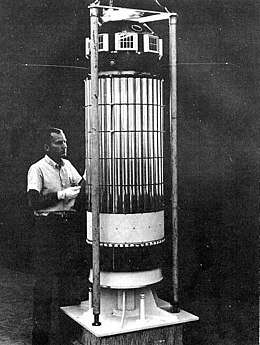Explorer 13
Explorer 13 (also called S-55A) was an American satellite launched as part of the Explorers program on August 25, 1961 from Wallops Flight Facility, Virginia, U.S.
 Explorer 13 (S-55A) | |||||||||||||
| Operator | NASA | ||||||||||||
|---|---|---|---|---|---|---|---|---|---|---|---|---|---|
| Harvard designation | 1961 χ1 | ||||||||||||
| COSPAR ID | 1961-022A | ||||||||||||
| SATCAT no. | 180 | ||||||||||||
| Website | 1961-022A[1] | ||||||||||||
| Mission duration | 3 days | ||||||||||||
| Spacecraft properties | |||||||||||||
| Manufacturer | GSFC | ||||||||||||
| Launch mass | 86 kg (190 lb) | ||||||||||||
| Start of mission | |||||||||||||
| Launch date | August 25, 1961, 19:26 UTC[2] | ||||||||||||
| Rocket | Scout X-1 | ||||||||||||
| Launch site | Wallops LA-3 | ||||||||||||
| End of mission | |||||||||||||
| Last contact | August 28, 1961 | ||||||||||||
| Orbital parameters | |||||||||||||
| Reference system | Geocentric | ||||||||||||
| Regime | Low Earth | ||||||||||||
| Eccentricity | 0.07392[1] | ||||||||||||
| Perigee altitude | 125 km (78 mi)[1] | ||||||||||||
| Apogee altitude | 1,164 km (723 mi)[1] | ||||||||||||
| Inclination | 37.7°[1] | ||||||||||||
| Period | 97.5 minutes[1] | ||||||||||||
| Epoch | August 25, 1961[1] | ||||||||||||
| Instruments | |||||||||||||
| |||||||||||||
Explorers | |||||||||||||
Weighing 187 pounds, including its fourth stage and transition section, its objective was to test the performance of a scout vehicle and its guidance system and to investigate the nature and effects of space flight on micrometeoroids. Its payload was a 76 inches x 24-inch cylinder, almost covered by five types of micometeoroid impact detectors, two transmitters, solar cells and nickel cadmium batteries. Its orbit was lower than planned and the satellite re-entered on August 27,1961.
Its Orbital Elements: Apogee 722 statute miles; Perigee 74 statute miles; Orbital Period 97.5 minutes.[3]
Mission
Explorer 13 was injected into a geocentric orbit of moderate eccentricity using a Scout launch vehicle. The objectives of the flight were to test vehicle performance and guidance and to investigate the nature and effects of micrometeoroids on the spacecraft systems. The scientific instrumentation consisted of cadmium sulfide-cell, wire-grid, piezoelectric, pressurized-cell, and foil-type micrometeoroid detectors.
The spacecraft was a 1.93 m × 0.61 m (6.3 ft × 2.0 ft) cylinder. The orbit was lower than planned, and the spacecraft reentered the atmosphere on August 28, 1961, after only slightly more than 2 days in orbit. No penetrations were recorded by this satellite during experiment operations. This aided in determination of useful flux limits for subsequent experiment design.
References
- "S 55A". NSSDC Master Catalog. NASA Goddard Space Flight Center.

- "Jonathan's Space Page".
- As of July 1962 - Goddard Space Flight Center / NASA * Profile of a satellite
.png)